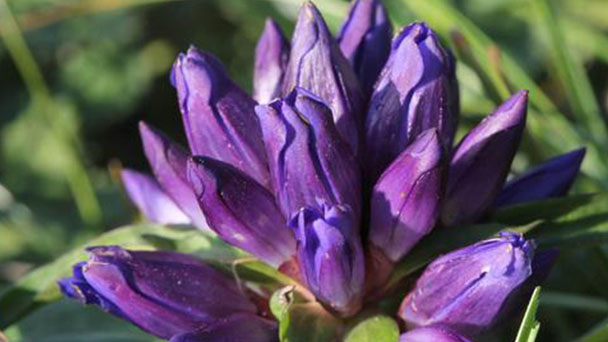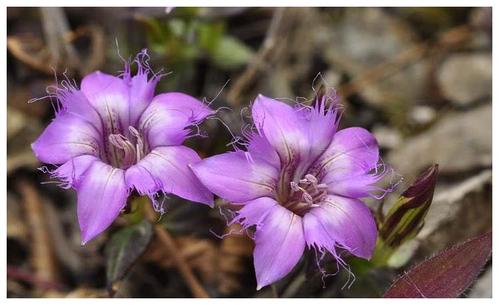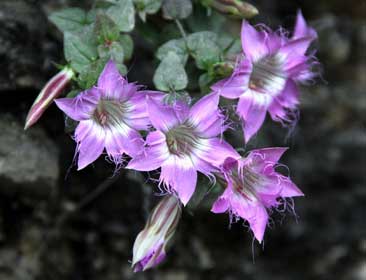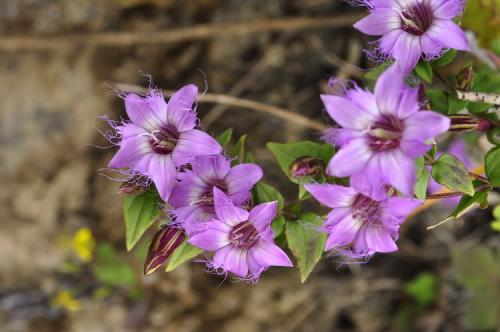Gentiana rhodantha profile
Written by Maggie
Mar 06 2021

Gentiana rhodantha is a perennial herb with a short rhizome. Gentiana rhodantha roots are slender, yellow. Stems are erect. Basal leaves rosulate, elliptic, obovate or ovate.
Gentiana Rhodantha picture

Morphological characteristics of Gentiana Rhodantha
Rhizome
Gentiana rhodantha is a perennial herb, 20 -- 50 cm tall, with a short rhizome. Roots are slender, yellow. Stems are erect, solitary or several fascicular, often purplish, with slender ribs, slightly scabrous, distally much-branched.
Leaf
Basal leaves of Gentiana Rhodantha roseate, elliptic, obovate, or ovate, 2-4 cm long, 0.7-2 cm wide, apically acute, basally cuneate, tapered to a short stalk 0.5-1 cm long, margin membranous and shallowly undulate; Cauline leaf width of Gentiana rhodantha is ovate or triangular oval, 1-3 cm long, 0.5 2 cm wide, apex acuminate or acute, base rounded or cordate, margin shallow wavy, veins 3-5, significantly below, sometimes thin coat, sessile or lower leaves very short and flat handle, 1-2 mm long, outside densely covered with short hairs or glabrous, base connate synthetic short tube amplexicaul.
Flowers
Flowers of Gentiana Rhodantha is solitary stem apical, pedicellate; Calyx is membranous, sometimes faintly purple, calyx tube 7 -- 13 mm long, veins slightly protuberant with narrow wings, lobes linear-lanceolate, 5 -- 10 mm long, margin sometimes sparsely lashes, curvilinear; Corolla of Gentiana rhodantha is reddish, with purple longitudinal stripes above, tubular, slightly spreading above, 3 -- 4.5 cm long, lobes ovate or ovate-triangular, 5 -- 9 mm long, 4 -- 5 mm wide, apex obtuse or acuminate, pleated broadly triangular, slightly shorter than lobes, 4 -- 5 mm wide, apex with slender fringes; Stamens are born in the lower part of the crown tube, filaments filiform, different lengths, the elder about 12 mm long, short about 5 mm long, anthers elliptic, about 3 mm long; Ovarian of Gentiana rhodantha is elliptic, ca. 10 mm long, stipe short, 4 -- 5 mm long, style filiform, ca. 6 mm long, stigma linear, 2-lobed.
Fruit
The capsule of gentiana rhodantha is concealed or only exserted at apex, pale brown, oblong, tapering at both ends, 2-2.5 cm long, 4 mm wide, thin pericarp, stalk 2 cm long; Seeds are pale brown, suborbicular, ca. 1 mm in diam., winged.
Ecological habits of Gentiana Rhodantha
Gentiana Rhodantha likes a cold and cool climate and has strong cold resistance; The temperature requirement is not strict, but when the seed germination, there must be a suitable temperature and certain light conditions, high temperature and humidity weather should be avoided in the seedling stage. Gentiana rhodantha grows well in moist soil, avoid drought, when drought tolerance is stronger. Too much moisture in the soil will affect the growth of gentian and cause root rot. Gentiana rhodantha prefers slightly acidic soil. Gentiana rhodantha has certain requirements for nutrients and generally grows well in fertile black loam soil, so the top dressing can not be applied. However, in the seedling stage, a certain amount of basal fertilizer can be applied because the seedling roots are relatively small and the ability to absorb fertilizer is poor.
The propagation of Gentiana Rhodantha
Seed
Gentiana rhodantha seed treatment: 1-3 days before sowing, use a small amount of alcohol after dissolving gibberellin, first with the aqueous solution soaked 12 hours, and then clean water species, the seed with hand control until no running water, with a 3% potassium nitrate aqueous solution at room temperature under three hours after seed soaking with clean water, to water colorless, control of the water, according to the seed and the fine sand 3-1 volume to the seed treatment.
Gentiana rhodantha seeding: spring sowing in spring advisable, after processing of seed per 100 square meters (dry) 0.2 0.25 kilograms of seeding rate, evenly spread on the whole good beds, then pat flat with a board or flat shovel will strip surface, combining the seeds and soil, and overburden layer on the surface of the strip length of pine needles or straw, the thickness of open country rather than the open field, about 12 cm long. It is better to sow early so that the seedlings have enough growth time, the seedlings are big and the roots are thick, and the overwintering buds are strong, which is beneficial to improve the survival rate of transplanting and form the strong winter buds of the tiger. Pay attention to the bed cover film moisture transmittance is better, autumn sowing need not deal with seeds, sowing method and spring sowing the same.
Division
Dig out underground roots and rhizomes in autumn, pay attention not to damage winter buds, cut rhizomes into more than three sections, with fibrous roots buried in the soil, cover the soil, keep the soil moist, the next year can grow into a new plant, spray a new fat film to protect the seedling growth.
Cutting
Before flower bud differentiation, cut adult Gentiana rhodantha branches, every three sections for cuttings, cut off the lower leaves, inserted in the prepared cutting seedbed, immediately watering, soil temperature 18-28℃ for about 3 weeks to take root, the survival rate and up to about 80%.

Disease control of Gentiana Rhodantha
Disease control
Damping-off
During the peak period in spring, cataplexy is caused by fungi. The symptoms are that the affected plants appear water stains on the leaves, and the plants lie down in pieces. After 5-8 days, the plants die, and the humidity is too high and the planting density is too high. If the disease starts, stop watering. Use 65% mancozeb 500 times solution or carbendazim and other fungicides for control.
Leaf rot
Leaf rot occurs after two pairs of true leaves to summer, the causes and symptoms of the disease are susceptible to leaf wilting, gradually black rot, serious root rot, the disease area is concentric circles spread to the surrounding, high temperature, humidity is conducive to the disease. After the onset of water suspension, with methyl tobujin 800 times solution or 50% carbendazim 1500 times solution irrigation area. Before the onset, carbendazim 700-800 times liquid or mancozeb 500 times liquid were used for a foliar spray for prevention.
Spot blight
This disease is a serious disease of gentian. There are brown round or oval lesions in the disinfected leaves, which are slightly lighter in color in the center and brown in the edge. There are black dots on both sides of the lesions, which are conidia in the fruiting body of the pathogen. In severe cases, the lesions converge, and the leaves of Gentiana Rhodantha wither and die, finally leading to the wilt of the whole plant. From the beginning of summer, the appliance was sprayed with 65% mancozeb 400-500 times liquid every 5-7 days.
Pest control
Mole cricket
After sowing in the bed of cover under mole crickets harm, the wheat bran fried incense, with 90% trichlorfon or Leguo 15 times the liquid wheat bran mix tide, a pile of a pile in the bed side, to kill. Poison bait is about 4-5 kg per mu.
Distribution of Gentiana Rhodantha
Gentiana Rhodantha is produced in Yunnan, Sichuan, Guizhou, Gansu, Shaanxi, Henan, Hubei, Guangxi, China.
The type specimen of Gentiana Rhodantha was collected from Yichang, Hubei Province.
The function and use of Gentiana Rhodantha
Ornamental value
Gentiana Rhodantha plants are colorful and colorful, with purple, white, blue, yellow and white and other colors, suitable for flower beds, flower mirrors or potted flowers. The gentian is no more than 40, 50 cm high, most of them are small and clumpy. There are many branches on one Gentiana Rhodantha, peanut at the top of the branches, into the ancient bell or funnel-shaped, there are 4-5 lobed, entire, also have finely lobed into the sea like whiskers. In autumn and winter, Gentiana Rhodantha flowers bloom in the yellow grass, appearing particularly simple and quiet. Gentiana Rhodantha flowers bloom in clusters, swaying in the wind, showing a quiet and elegant, simple and quiet beauty, thus becoming a famous flower.
Medical value
The whole strain is used for tuberculosis, lymphatic tuberculosis, bronchial asthma, solid heat and wheezing cough, adverse urination, infantile malnutrition, fire eye, jaundice hepatitis.

Latest Updated
- Benefits of Bugleweed - 7 Science-backed Health Benefits
- Bugleweed Dangers & Side Effects - Is It Poisonous?
- How to Plant Evergreen Trees - What You Should Know
- When to Plant Evergreens - Grow Guide for Evergreen Trees
- 12 Wonderful Evergreen Shrubs for Your Garden
- 12 Popular Evergreen Plants with Pictures for Beginners
- When And How To Prune A Lilac Bush Like a Pro
- How to Grow & Care for Lilac Vine (Hardenbergia Violacea)
- Japanese Lilac Tree (Syringa Reticulata) Care & Propagation Guide
- Shumard Oak Pros and Cons - What to Know
Popular Articles
- Winter maintenance of Antirrhinum Majus
- How to Grow Terminalia Mantaly Tree
- How to Grow and Care for Crossostephium Chinense
- How to grow Antirrhinum Majus in spring
- Peristeria Elata (Dove Orchid) Profile: Info & Care Guide
- Underwatered Snake Plant (Sansevieria Trifasciata) - Signs And How To Fix
- How to Care for Brazilian Jasmine Plant (Mandevilla Sanderi)
- How to Grow & Care for Graptopetalum Purple Delight in Summer
- Rosa Chinensis (China Rose): Plant Growing & Care Tips
- How to Care for Baby Sun Rose (Aptenia Cordifolia)